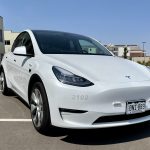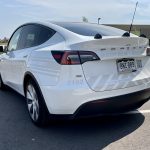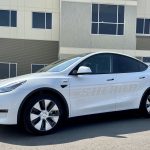
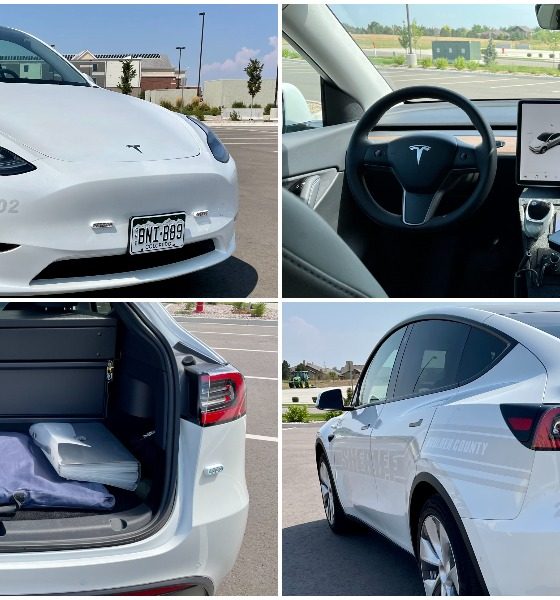
News
Tesla-owning Officer convinces Sheriff’s Office a Model Y would be perfect fit
Sergeant Clay Leak of the Boulder, Colorado Sheriff’s Office has several Teslas in his garage, but one at his job would have been a cherry on top. After a few months of diligence, Sgt. Leak has a Model Y in his Boulder Sheriff’s Office fleet, making it the latest force to introduce all-electric power into its law enforcement efforts.
It was a long process, Leak told Teslarati in an interview earlier this month. It took a lot of work, and it took a lot of phone calls, but eventually, things worked out as they should have. “I did a bunch of research by reading a bunch of articles, then reaching out to talk to agencies that I could get ahold of who had Teslas in their fleet,” Leak told us. He started with the Fremont, Westport, Bargersville, and Hastings-on-Hudson Departments, all of which have welcomed Tesla vehicles into their fleets. Fremont has a Model S, Westport and Bargersville a Model 3, and Hastings-on-Hudson would operate that same model as Boulder: a Model Y Long Range.
- Credit: Sgt. Clay Leak of Boulder PD
- Credit: Sgt. Clay Leak of Boulder PD
- Credit: Sgt. Clay Leak of Boulder PD
The process then seemed to make sense as the financial figures lined up nicely for a presentation to local commissioners who would ultimately have the final say. “I talked to our in-house fleet manager and pulled the mileage, fueling, maintenance, and service records for our fleet,” Leak said. He did not think it would be a very difficult convincing process as cutting costs of fueling and maintenance swayed in the direction of the Model Y. After calculating Wh/mi for the Tesla and comparing it to the cost of operating a gas-powered Ford Police Interceptor, it was no match. The Model Y was around five times as cost-effective than the typical Police Cruiser. Plus, the sustainability factor was another big positive in the way of purchasing the Model Y.
“Boulder County has always strived to be eco-friendly in all our operations, and we continue that commitment by being one of the first, if not the first law enforcement agency in the State of Colorado to bring a Tesla Model Y into our patrol fleet,” the department wrote.
Within six months, the Model Y could already begin saving the Department money, according to a Media Release the department published earlier this week. After the Command Officers agreed with Leak’s calculations and ideas for a sustainable member of the fleet to be added, it went to Boulder County Commissioners, who ultimately approved the project and authorized the purchase.
“I think taxpayers will be happy to hear that this new vehicle will save money,” Leak said. “It will take time, but it will be less expensive than the gas-powered vehicles we have now.”
Then came the fun part, installing the necessary police equipment on the inside of the car, and outfitting the Model Y with decals. “We worked with Tesla, because there were some things that just didn’t line up,” Leak stated. He detailed how the programs the Boulder Sheriff’s Office uses are Windows-based, while the Model Y’s center dash screen is HTML-based. This made it necessary to install a patrol laptop, which is in normal cruisers as well.
The Department said in its release:
“The vehicle has been outfitted with official Boulder County Sheriff’s Office decals as well as a full suite of emergency equipment like that used in many of our other vehicles. It will primarily be assigned for traffic enforcement, though it will be rigorously tested to examine its potential for other applications within the Sheriff’s Office. Our research included examining EV offerings from other manufacturers, but they were ultimately eliminated from consideration due to significantly higher price points, lack of availability, and/or specifications that did not meet our needs. We are open to reconsidering them in the future as the EV market expands.”
Credit: Sgt. Clay Leak of Boulder PD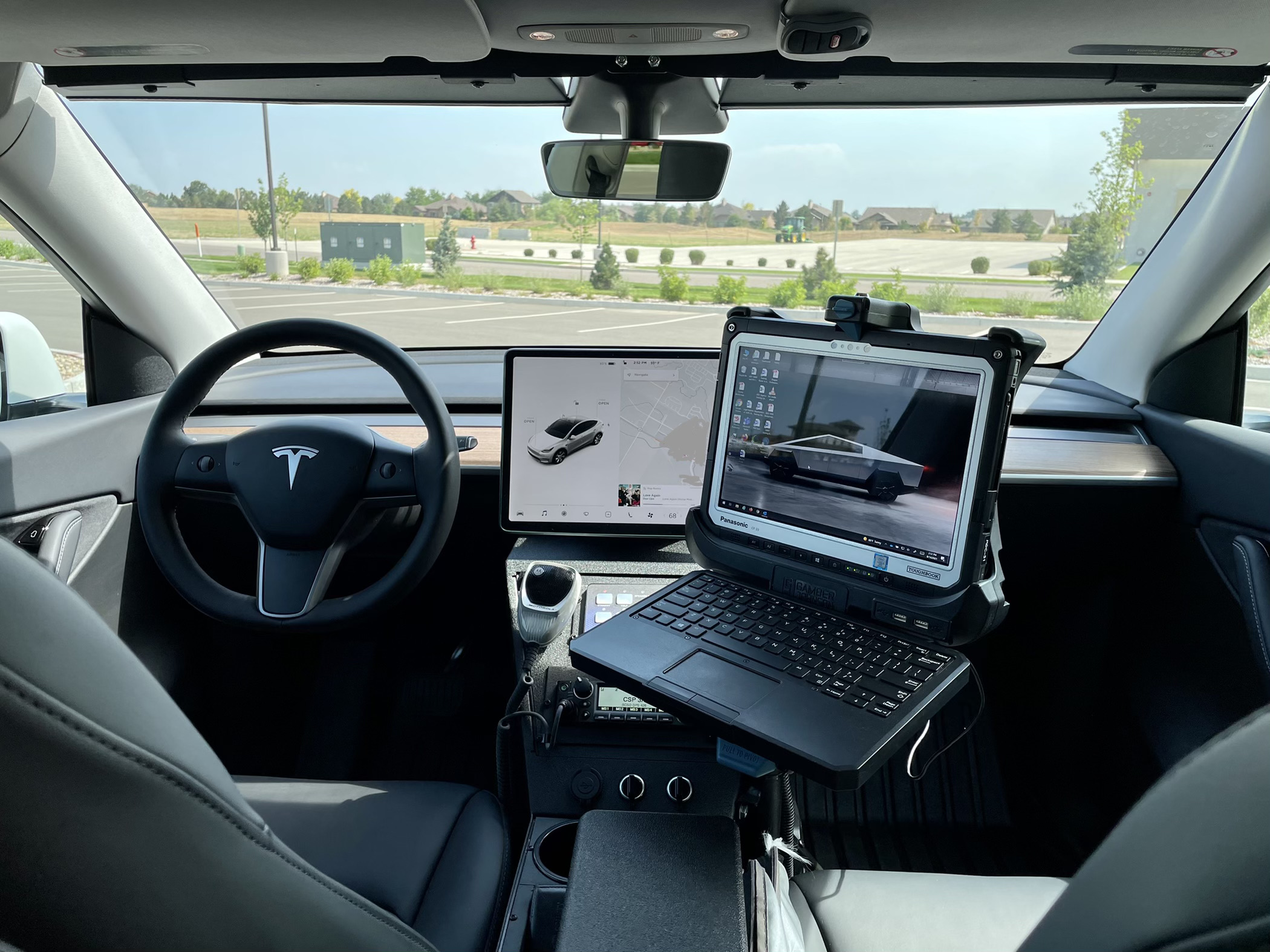
The Department expects the vehicle to make it 200,000 miles at minimum. However, Leak is looking to increase the sustainability of the Model Y Cruiser by offsetting electricity costs with solar panels.
Don’t hesitate to contact us with tips! Email us at tips@teslarati.com, or you can email me directly at joey@teslarati.com.

Elon Musk
Elon Musk and Tesla AI Director share insights after empty driver seat Robotaxi rides
The executives’ unoccupied tests hint at the rapid progress of Tesla’s unsupervised Robotaxi efforts.

Tesla CEO Elon Musk and AI Director Ashok Elluswamy celebrated Christmas Eve by sharing personal experiences with Robotaxi vehicles that had no safety monitor or occupant in the driver’s seat. Musk described the system’s “perfect driving” around Austin, while Elluswamy posted video from the back seat, calling it “an amazing experience.”
The executives’ unoccupied tests hint at the rapid progress of Tesla’s unsupervised Robotaxi efforts.
Elon and Ashok’s firsthand Robotaxi insights
Prior to Musk and the Tesla AI Director’s posts, sightings of unmanned Teslas navigating public roads were widely shared on social media. One such vehicle was spotted in Austin, Texas, which Elon Musk acknowleged by stating that “Testing is underway with no occupants in the car.”
Based on his Christmas Eve post, Musk seemed to have tested an unmanned Tesla himself. “A Tesla with no safety monitor in the car and me sitting in the passenger seat took me all around Austin on Sunday with perfect driving,” Musk wrote in his post.
Elluswamy responded with a 2-minute video showing himself in the rear of an unmanned Tesla. The video featured the vehicle’s empty front seats, as well as its smooth handling through real-world traffic. He captioned his video with the words, “It’s an amazing experience!”
Towards Unsupervised operations
During an xAI Hackathon earlier this month, Elon Musk mentioned that Tesla owed be removing Safety Monitors from its Robotaxis in Austin in just three weeks. “Unsupervised is pretty much solved at this point. So there will be Tesla Robotaxis operating in Austin with no one in them. Not even anyone in the passenger seat in about three weeks,” he said. Musk echoed similar estimates at the 2025 Annual Shareholder Meeting and the Q3 2025 earnings call.
Considering the insights that were posted Musk and Elluswamy, it does appear that Tesla is working hard towards operating its Robotaxis with no safety monitors. This is quite impressive considering that the service was launched just earlier this year.
Elon Musk
Starlink passes 9 million active customers just weeks after hitting 8 million
The milestone highlights the accelerating growth of Starlink, which has now been adding over 20,000 new users per day.

SpaceX’s Starlink satellite internet service has continued its rapid global expansion, surpassing 9 million active customers just weeks after crossing the 8 million mark.
The milestone highlights the accelerating growth of Starlink, which has now been adding over 20,000 new users per day.
9 million customers
In a post on X, SpaceX stated that Starlink now serves over 9 million active users across 155 countries, territories, and markets. The company reached 8 million customers in early November, meaning it added roughly 1 million subscribers in under seven weeks, or about 21,275 new users on average per day.
“Starlink is connecting more than 9M active customers with high-speed internet across 155 countries, territories, and many other markets,” Starlink wrote in a post on its official X account. SpaceX President Gwynne Shotwell also celebrated the milestone on X. “A huge thank you to all of our customers and congrats to the Starlink team for such an incredible product,” she wrote.
That growth rate reflects both rising demand for broadband in underserved regions and Starlink’s expanding satellite constellation, which now includes more than 9,000 low-Earth-orbit satellites designed to deliver high-speed, low-latency internet worldwide.
Starlink’s momentum
Starlink’s momentum has been building up. SpaceX reported 4.6 million Starlink customers in December 2024, followed by 7 million by August 2025, and 8 million customers in November. Independent data also suggests Starlink usage is rising sharply, with Cloudflare reporting that global web traffic from Starlink users more than doubled in 2025, as noted in an Insider report.
Starlink’s momentum is increasingly tied to SpaceX’s broader financial outlook. Elon Musk has said the satellite network is “by far” the company’s largest revenue driver, and reports suggest SpaceX may be positioning itself for an initial public offering as soon as next year, with valuations estimated as high as $1.5 trillion. Musk has also suggested in the past that Starlink could have its own IPO in the future.
News
NVIDIA Director of Robotics: Tesla FSD v14 is the first AI to pass the “Physical Turing Test”
After testing FSD v14, Fan stated that his experience with FSD felt magical at first, but it soon started to feel like a routine.

NVIDIA Director of Robotics Jim Fan has praised Tesla’s Full Self-Driving (Supervised) v14 as the first AI to pass what he described as a “Physical Turing Test.”
After testing FSD v14, Fan stated that his experience with FSD felt magical at first, but it soon started to feel like a routine. And just like smartphones today, removing it now would “actively hurt.”
Jim Fan’s hands-on FSD v14 impressions
Fan, a leading researcher in embodied AI who is currently solving Physical AI at NVIDIA and spearheading the company’s Project GR00T initiative, noted that he actually was late to the Tesla game. He was, however, one of the first to try out FSD v14.
“I was very late to own a Tesla but among the earliest to try out FSD v14. It’s perhaps the first time I experience an AI that passes the Physical Turing Test: after a long day at work, you press a button, lay back, and couldn’t tell if a neural net or a human drove you home,” Fan wrote in a post on X.
Fan added: “Despite knowing exactly how robot learning works, I still find it magical watching the steering wheel turn by itself. First it feels surreal, next it becomes routine. Then, like the smartphone, taking it away actively hurts. This is how humanity gets rewired and glued to god-like technologies.”
The Physical Turing Test
The original Turing Test was conceived by Alan Turing in 1950, and it was aimed at determining if a machine could exhibit behavior that is equivalent to or indistinguishable from a human. By focusing on text-based conversations, the original Turing Test set a high bar for natural language processing and machine learning.
This test has been passed by today’s large language models. However, the capability to converse in a humanlike manner is a completely different challenge from performing real-world problem-solving or physical interactions. Thus, Fan introduced the Physical Turing Test, which challenges AI systems to demonstrate intelligence through physical actions.
Based on Fan’s comments, Tesla has demonstrated these intelligent physical actions with FSD v14. Elon Musk agreed with the NVIDIA executive, stating in a post on X that with FSD v14, “you can sense the sentience maturing.” Musk also praised Tesla AI, calling it the best “real-world AI” today.
